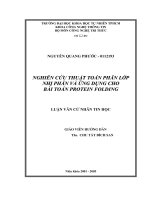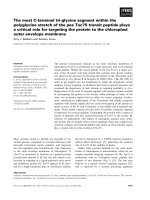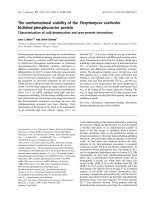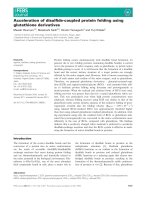ditorial: hypotheses about protein folding - the proteomic code and wonderfolds" pot
Bạn đang xem bản rút gọn của tài liệu. Xem và tải ngay bản đầy đủ của tài liệu tại đây (152.22 KB, 2 trang )
BioMed Central
Page 1 of 2
(page number not for citation purposes)
Theoretical Biology and Medical
Modelling
Open Access
Editorial
Editorial: hypotheses about protein folding - the proteomic code
and wonderfolds
Paul S Agutter
Address: Theoretical Medicine and Biology Group, 26 Castle Hill, Glossop, Derbyshire, SK13 7RR, UK
Email: Paul S Agutter -
Abstract
Theoretical biology journals can contribute in many ways to the progress of knowledge. They are
particularly well-placed to encourage dialogue and debate about hypotheses addressing
problematical areas of research. An online journal provides an especially useful forum for such
debate because of the option of posting comments within days of the publication of a contentious
article.
Editorial
'Theoretical biology' encompasses proposals ranging from
new mathematical models of well-studied biological
processes to speculative notions that inhabit the border-
land between science and philosophy. Theoretical Biology
and Medical Modelling can accommodate everything
within that range subject to peer review and editorial
approval. Novel hypotheses addressing phenomena that
have defied satisfactory explanation are especially wel-
come, provided they meet the basic criterion of testability
(at least in principle), because they can stimulate debate
or excite controversy and are ipso facto healthy for science.
Theoretical biology has not enjoyed the status of, say, the-
oretical physics because biology is primarily a science of
particular phenomena rather than general laws. 'Grand
theories' in biology seldom prove useful or even tenable,
as some widely-discussed instances have shown during
the past decade. Nevertheless, there are problematic areas
of the life sciences that invite theoretical exploration. Pro-
tein folding is an example. Most research in this field, as
in others, is empirical and pertains a fortiori to only a lim-
ited range of polypeptides and/or species (e.g. [1,2]).
Broad hypotheses about general mechanisms of protein
folding may therefore initiate significant contributions to
knowledge.
The 'proteomic code' is one such hypothesis. Its basic
claim is that while protein primary structure is encoded in
the base sequence of mRNA, the rules for protein folding
are encoded in other features of messenger structure. Jan
Biró of the Homulus Foundation, Los Angeles, has devel-
oped the idea in a recent series of papers [3-6], some of
them published in this journal, and has recently pub-
lished a book that explains it in detail [7]. The proteomic
code hypothesis is likely to find support among some
workers in the protein structure field, but is equally likely
to find powerful opponents.
Biró's point of departure is the well-known redundancy of
the genetic code. Studying 81 messengers, he showed
[3,4] that mRNA subsequences comprising 1st and/or 3rd
codon residues have significantly higher free folding ener-
gies than subsequences containing only 2nd residues (p <
0.0001). No such periodically distributed differences in
free folding energy were found in intron transcripts. This
suggests selection for local secondary structures in RNA
coding regions, and these structures resemble the folding
Published: 24 December 2009
Theoretical Biology and Medical Modelling 2009, 6:31 doi:10.1186/1742-4682-6-31
Received: 16 December 2009
Accepted: 24 December 2009
This article is available from: />© 2009 Agutter; licensee BioMed Central Ltd.
This is an Open Access article distributed under the terms of the Creative Commons Attribution License ( />),
which permits unrestricted use, distribution, and reproduction in any medium, provided the original work is properly cited.
Publish with BioMed Central and every
scientist can read your work free of charge
"BioMed Central will be the most significant development for
disseminating the results of biomedical research in our lifetime."
Sir Paul Nurse, Cancer Research UK
Your research papers will be:
available free of charge to the entire biomedical community
peer reviewed and published immediately upon acceptance
cited in PubMed and archived on PubMed Central
yours — you keep the copyright
Submit your manuscript here:
/>BioMedcentral
Theoretical Biology and Medical Modelling 2009, 6:31 />Page 2 of 2
(page number not for citation purposes)
profiles of the encoded proteins. In particular, codons
synonymous in respect of their encoded amino acids may
nevertheless signify differences in protein secondary or
tertiary structure. Thus, messengers not only direct the
assembly of polypeptides with the correct primary
sequence (the genetic code), they also direct the correct
folding of those polypeptides (the proteomic code) [5,6].
This concept was first suggested a quarter of a century ago
by Biró himself, and independently by Mekler, and was
developed in studies by Blalock, Root-Bernstein, Siemion,
Miller and others [7]. In 2003, Biró and colleagues pub-
lished a common periodic table of codons and amino
acids, which elaborates the proteomic code hypothesis in
specific detail [8]. The idea is strikingly consistent with
studies such as those of Chiusano et al. [9], who showed
that the nucleotide frequencies in second codon positions
are remarkably different among coding regions that corre-
spond to different protein secondary structures and to
amino acids with different physicochemical properties. It
is also broadly compatible with the work of Ikehara and
colleagues [10,11] and of Rodin and Rodin [12] on the
origin and evolution of the genetic code.
However, some research conflicts with the proteomic
code concept. A salient example is the work by Berezovsky
and colleagues [13,14], whose emphasis is on polymer
physics and on the selection for protein stability that
causes preferred polypeptide structures to emerge. These
authors have identified structural motifs that they dub
'wonderfolds', which arise repeatedly as native states of
stable polypeptides resulting from the mutation and selec-
tion of random sequences. They reason that superfamilies
with wonderfolds may have played an important part in
early evolution. This approach to the study of protein
folding has no connection at all with mRNA structure or
the distinctive properties of codon bases. It seems likely
that Berezovsky and his colleagues would dismiss the pro-
teomic code hypothesis as speculative and unproductive,
whereas proponents of the proteomic code may wish to
relate 'wonderfolds' to particular recurrent combinations
of mRNA codons (which would then, in turn, require
explanation).
This is a potentially fruitful arena for continuing debate
and discussion. Currently, the main questions seem to be
(1) whether either hypothesis satisfactorily explains
empirical results such as those in [1,2] and (2) whether
the two hypotheses - which at present seem incompatible
- can ultimately be reconciled. By fostering the further
exploration of these and related questions, theoretical
biology journals are in a position to make valuable contri-
butions to knowledge. Theoretical Biology and Medical Mod-
elling is particularly well placed in this regard because it
provides the option of posting comments on contentious
articles within days of their online publication.
References
1. Preuss M, Miller AD: The affinity of the GroEL/GroES complex
for peptides under conditions of protein folding. FEBS Lett
2000, 466:75-79.
2. Pintar A, Pongor S: The "first in-last out" hypothesis on protein
folding revisited. Proteins 2005, 60:584-590.
3. Biró JC: Indications that "codon boundaries" are physico-
chemically defined and that protein-folding information is
contained in the redundant exon bases. Theor Biol Med Model
3:28.
4. Biró JC: Protein folding information in nucleic acids which is
not present in the genetic code. Ann N Y Acad Sci 2006,
1091:399-411.
5. Biró JC: The Proteomic Code: a molecular recognition code
for proteins. Theor Biol Med Model 4:45.
6. Biró JC: Discovery of proteomic code with mRNA assisted
protein folding. Int J Mol Sci 2008, 9:2424-2446.
7. Biró JC: Principia Bi®o-Informatica. Creative ideas in Molecular Biology &
Bioinformatics Los Angeles: Homulus Foundation; 2009. ISBN 978-0-
9842103-1-2
8. Biro JC, Benyó B, Sansom C, Szlávecz A, Fördös G, Micsik T, Benyó
Z: A common periodic table of codons and amino acids. Bio-
chem Biophys Res Commun 2003, 306:408-415.
9. Chiusano ML, Alvarez-Valin F, Di Giulio M, D'Onofrio G, Ammirato
G, Colonna G, Bernardi G: Second codon positions of genes and
the secondary structures of proteins. Relationships and
implications for the origin of the genetic code. Gene 2000,
261:63-69.
10. Ikehara K, Niihara Y: Origin and evolutionary process of the
genetic code. Curr Med Chem 2007, 14:3221-3231.
11. Ikehara K: Pseudo-Replication of [GADV]-proteins and origin
of life. Int J Mol Sci 2009, 10:1525-1537.
12. Rodin SN, Rodin AS: On the origin of the genetic code: signa-
tures of its primordial complementarity in tRNAs and ami-
noacyl-tRNA synthetases. Heredity 2008, 100:341-355.
13. Berezovsky IN, Trifonov EN: Flowering buds of globular pro-
teins: transpiring simplicity of protein organization. Comp
Funct Genomics 2002, 3:525-534.
14. Zeldovich KB, Berezovsky IN, Shakhnovich EI: Physical origins of
protein superfamilies. J Mol Biol 2006, 357:1335-1343.









